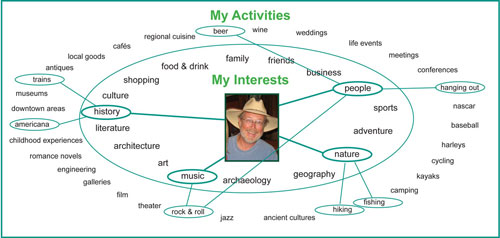Research: Figure and Ground
Research involves understanding both the context (the ‘ground’), and the user (the ‘figure’). Both are vitally important to developing a successful strategy.
Understanding the context requires both the development of a clear mission statement (what are we trying to do?) as well as some sort of market and capabilities analysis (what is possible?). Without contextual understanding, projects risk devolving into hypothetical models that don’t provide concrete and actionable solutions.
This is not to discount the importance of brainstorming and ideation – the goal of design strategy is always to find new opportunities that weren’t apparent previously – but rather to understand that design is always about working within restrictions. Teams will often attempt to jump right into the ideation process without first defining clear goals, which can quickly hamstring a project and create frustration. In my experience, not spending time on defining the project’s goals is one of the most frequent causes of failure in a design strategy project.
Contextual analysis can be done in a number of ways; I usually begin with some combination of stakeholder interviews and competitive analysis. Depending on the complexity of the project, I’ll also often conduct a multidisciplinary “visioning session” with stakeholders from within the organization. The extent of this research may vary widely depending on the scope of the project and the resources of the organization; as an example, a two-hour visioning session may be all that is needed for a new interactive marketing and communications plan for a non-profit organization, while it may take months of effort to pull together the right combination of information to understand the market context for a new product or service.
In addition to developing a mission and vision for the project, one of the outputs of the contextual analysis is a map of the potential audience for the product or service being designed. This map then serves as a starting place for the next phase of research.
Understanding the Individual
Former Congressman and Speaker of the House Tip O’Neill was fond of saying that “all politics is local.” I believe that all design strategy projects are local, or even more to the point, all design strategy is focused on engaging the needs of the individual. In order to do this, there needs to be an understanding of the individual, and to provide specific solutions that meet the needs and desires of the individual.

Of course, there’s no way to understand (or design) the experience of every individual – in fact, some thoughtful folks including Hugh Dubberly have argued persuasively that there is no such thing as ‘experience design’ – and given the nature of interaction, it’s ultimately not desirable to do so. Our goal is to create a framework to allow the individual to engage and enhance the experience in their own way.
But in the research phase of our project, our goal is to spend whatever time and energy we can (within the limitations of the timeline) gaining insight into the various individuals who will be using the proposed solution. On a small project, this may be as simple as interviewing one or two co-workers or friends – it’s possible that a ‘test group of one’ could offer the insight you need.
Other projects (okay, most projects) require more effort in terms of people-centered research. My own process usually involves selecting as broad a range of individuals from the target audience as possible. So, if we’re designing a downtown library, we’d want to take a look at some combination of employees, volunteers, historical researchers, mystery readers, event attendees, children, homeless people, and more, and then decide on what cross-section we can conduct our research on. Depending on the complexity of the project, I usually limit the number of research subjects to between 10 and 12, as after that I usually begin to see repetition in the findings.
Although interviews are a good starting point (and sometimes all that can be arranged), I prefer to engage in look at other methods of fieldwork that can provide more meaningful data to use in analysis and interpretation. If it’s a physical space, pure observation (live, or via video or photography) can be helpful. Sometimes it’s useful to engage the audience more directly in the process (via photo journaling, for instance). The truth is that there are hundreds of different techniques for conducting ethnographic fieldwork, and the most effective approach needs to be specific to the context of the particular project.